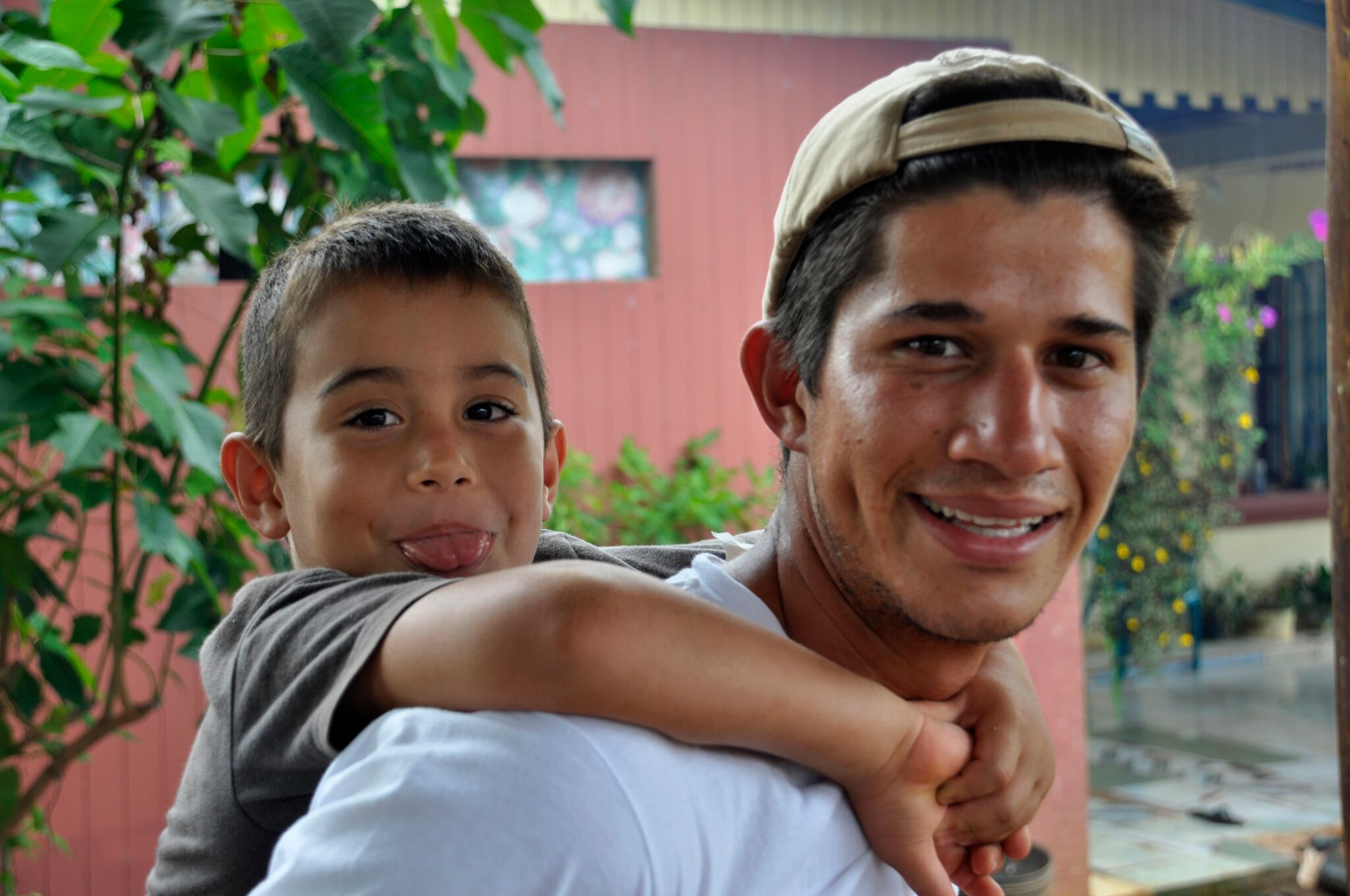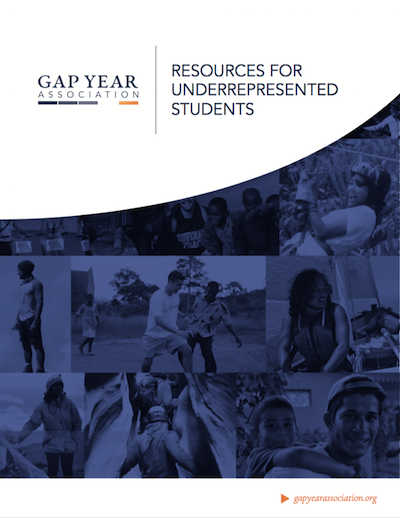Inclusion and Access in Gap Years

Deciding to take a Gap Year can feel like a big commitment of time, energy, and finances; but it’s worth it! Gap Year alumni are more likely to experience both higher levels of college success as well as lasting job fulfillment following their time abroad. Unfortunately, as of 2017, the majority of participants on Gap Year programs are predominately white, female students from middle and higher socioeconomic backgrounds. Students of color, first generation college students, immigrant students, and male students continue to experience inaccessibility and underrepresentation.
International education and service programs are often portrayed as a white, female-dominant endeavor, which is unnecessarily exclusive and overly-reductive. Of their many characteristics, these abroad experiences offer all students (regardless of background and gender) with the opportunity to develop higher levels of emotional and cultural intelligence, and ultimately empathy (among many other things).
To help make this valuable experience more attainable and assessable, GYA has researched certain barriers to equal representation in Gap Years, as well as some tools and strategies for overcoming them. These strategies serve as bridges for underrepresented students, so that they may thrive throughout a Gap Year experience, and so that we can collectively continue to move towards diverse sustainability in Gap Year Education.
We hope they help! If you have additional questions, comments, or resources, please reach out to us directly.
Barriers:
The following six areas are the most common barriers for students when it comes to participating in a Gap Year: Economic, Representation & Visibility, Faculty & Administrative Support, Family Support, Community & Social Support, Prejudice & Discrimination
Economic
Gap year funds are not readily accessible to all students; and gap years can be expensive. Good gap years do not have to be expensive, but the perception is that they are, and that is limiting.
Representation and Visibility
Gap years are not as visible to students from different socioeconomic or ethnic backgrounds, and are not as representative of students of color or students with disabilities.
Faculty and Administrative Support
If high school, college, and university faculty are not actively mentoring and supporting students, it will be extremely difficult for students to plan or even consider taking a gap year.
Family Support
Many students who come from predominantly white, economically-advantaged households have had parents who themselves studied or traveled abroad; this makes it easier for them to navigate the going abroad experience. This support is less common for students of color, first generation college students, and immigrant students, whose families may be wary about the costs, benefits, and potential risks of venturing abroad on a gap year. Often students in these situations are also responsible for sibling or elder care within their families, and/or contributing to the family’s finances, which makes spending time away a more significant challenge.
Community and Social Support
Similar to family support, if a student lacks community and social exposure to the concept of a gap year, they are less likely to know how the process works. Without seeing others such as neighbors, friends, and other community members engage in a gap year experience, students will have more difficulties in finding the trust and motivation to participate.
Prejudice and Discrimination
Many underrepresented students have familiarized themselves with the challenges they face daily at home, yet struggle to understand what to expect once they go abroad. In preparation for her semester abroad as a person of color, a student once remarked: “I know how to deal with the racism at home; I don’t know what to expect abroad.” It can be difficult to know how to brave these unknown environments as an underrepresented student; and these concerns can be stifling.
Strategies To Support Diverse Student Populations

These barriers present significant challenges to students and families, gap year practitioners, and colleges and universities; however, there are several actions each party can take to minimize them. Gap year practitioners and colleges and universities in particular can help facilitate and enrich gap year participation for more students, and can work to ensure the experience is one in which all students thrive.
We are constantly seeking ways to improve these suggestions and so encourage any interested person in supporting this very important work by contacting us, joining the Gap Year Association as a Member, or otherwise helping to educate your neighbors about the great benefits found in an intentional gap year, and the even greater benefits found in a gap year with diverse students!
For Students and Families:
Economic
- Ask your college or university about financial aid
- Research program-specific scholarships or grants
- Research general scholarships or grants
- Research educational travel scholarships (e.g. GoOverseas, GoAbroad, Volunteer Forever)
- Partake in crowdfunding or personal fundraising (e.g. GoFundMe, Razoo, Fundly)
- Consider working with a Gap Year Counselor
Representation and Visibility/Faculty and Administrative Support
- Share! Write essays and circulate your stories through social media and beyond
- Participate in gap year alumni networks
- Be a mentor or a guide for prospective Gap Year students
- If you are a prospective gap year student, seek out alumni to share their experiences
- Check your college/university to see if they have a Gap Year Club for connecting with alumni; or, start your own!
Family Support
- Contact gap year programs with lots of questions
- Ask how they support their underrepresented students
- Ask about the benefits of taking a gap year
- Talk to an alumni of the program or a family member of an alumni
- Ask alumni about their initial concerns, or advice they would give to prospective gap year students
Community and Social Support
- Communicate your experience to others in your community
- Explain why you decided to take a gap year, and why you would recommend one
- Share photos and videos of your gap year on social media
- Tell others about the benefits of your gap year, and how you plan to apply your time abroad to your future career path
- Consider presenting on your experience at schools or educational organizations
- Connect with local gap year communities to get more involved
- If you're a prospective gap year student, seek out alumni through gap year program alumni networks (or other alumni channels) and ask them lots of questions
Prejudice & Discrimination
- Ask gap year programs about their policies and procedures for responding to incidents of discrimination, and make sure they offer plenty of support and protection
- Ask for examples of what to expect in terms of racism and discrimination, or lack of mobility or accessibility
- Ask about the country's laws, and how the program plans to help alleviate any mobility or discrimination challenges
- Talk with alumni who can share their first-hand experience
- Ask alumni about their experience with safety and discrimination, how to prepare for going abroad, and any other advice they would share
- Make a strategy with your gap year program on how to stay safe and protected
- Make sure you know what to do and who to contact if something should happen
For Gap Year Practitioners:
Economic
- Consider offering new and/or expanded student scholarships
- Offer diversity-focused grants for specifically underrepresented students
Representation and Visibility/Faculty and Administrative Support
- Reach out to alumni from diverse backgrounds to share their experiences
- Highlight the stories of underrepresented students on social media and in marketing materials
- Consider creating volunteer positions that engage alumni as mentors and guides for prospective students
- Consider offering a cohort program so students can create a network with peers from similar backgrounds
Family Support
- Foster and sustain robust alumni networks
- Host subgroups for alumni with specific identities (e.g. students of color, LGBTQIA students, students with disabilities, etc)
- Make these networks available to prospective students so they can build relationships
- Consider creating a network just for parents or family members
- Have materials available in different languages
- Consider offering programs of varying lengths, as shorter programs may be better suited for students with familial responsibilities
Community and Social Support
- Share alumni stories with media that is dynamic and accessible
- Include underrepresented students in marketing materials and content
- Post interactive media on your website (e.g. photos, videos, soundbites, etc) and make re-sharing easy
- Consider offering cohort model programs that foster communities of peer support
Prejudice & Discrimination
- Be honest: racism and discrimination exist everywhere
- Share how mobility for students with disabilities will be limited in many places
- Tell students what to expect and provide them with tools for responding to it
- Have clear and transparent policies and procedures that protect and prepare students
- Train your staff with fast-thinking and compassionate response techniques to incidents of discrimination
- Connect applicants and participants with alumni who can share first-hand experiences of what to expect
For Colleges and Universities:
Economic
- Research and identify diverse gap year programs
- Research and identify gap year programs that offer grants and scholarships
- Share helpful resources on financial aid with students
- Consider offering gap year scholarships for future participants or for returning alumni
- Create clear policies and procedures for student deferral during a gap year
Representation and Visibility/Faculty and Administrative Support
- Identify students who would benefit from gap years
- Provide staff and faculty of color for mentorship of students of color
- Seek out leaders of color on campus to help raise awareness of representation in gap years
- Identify members of your campus community that can serve as advocates for representation in gap years
- Create clubs and/or opportunities for underrepresented students to socialize and connect with one another
- Have clear deferral policies for admissions and scholarship awards for students who choose to take a gap years
Family Support
- Identify gap year programs with strong alumni networks
- Connect families to gap year coordinators/alumni to answer questions
- Train staff to better understand barriers for underrepresented students and families
Community and Social Support
- Collect diverse stories from students who are gap year alumni
- Share these stories widely with your campus network and on social media
- Use visually-engaging mediums and encourage students to repost your content
- Consider creating campus clubs for gap year alumni so students can more easily connect and create communities of support
Prejudice & Discrimination
- Research Gap Year organizations that demonstrate understanding and support for underrepresented students
- Request copies of their policies and procedures
- Ask organizations about prevention measures, and their response processes should discrimination occur
